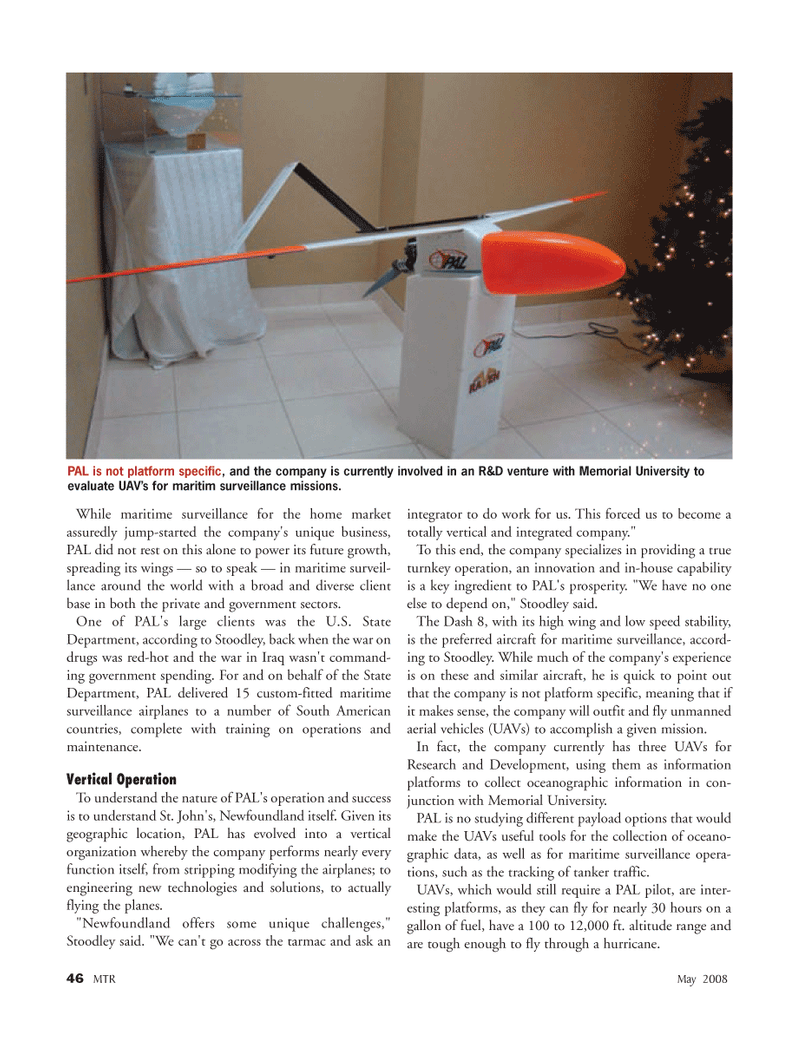
Page 46: of Marine Technology Magazine (May 2008)
Undersea Defense Edition
Read this page in Pdf, Flash or Html5 edition of May 2008 Marine Technology Magazine
46 MTR May 2008
While maritime surveillance for the home market assuredly jump-started the company's unique business,
PAL did not rest on this alone to power its future growth, spreading its wings — so to speak — in maritime surveil- lance around the world with a broad and diverse client base in both the private and government sectors.
One of PAL's large clients was the U.S. State
Department, according to Stoodley, back when the war on drugs was red-hot and the war in Iraq wasn't command- ing government spending. For and on behalf of the State
Department, PAL delivered 15 custom-fitted maritime surveillance airplanes to a number of South American countries, complete with training on operations and maintenance.
Vertical Operation
To understand the nature of PAL's operation and success is to understand St. John's, Newfoundland itself. Given its geographic location, PAL has evolved into a vertical organization whereby the company performs nearly every function itself, from stripping modifying the airplanes; to engineering new technologies and solutions, to actually flying the planes. "Newfoundland offers some unique challenges,"
Stoodley said. "We can't go across the tarmac and ask an integrator to do work for us. This forced us to become a totally vertical and integrated company."
To this end, the company specializes in providing a true turnkey operation, an innovation and in-house capability is a key ingredient to PAL's prosperity. "We have no one else to depend on," Stoodley said.
The Dash 8, with its high wing and low speed stability, is the preferred aircraft for maritime surveillance, accord- ing to Stoodley. While much of the company's experience is on these and similar aircraft, he is quick to point out that the company is not platform specific, meaning that if it makes sense, the company will outfit and fly unmanned aerial vehicles (UAVs) to accomplish a given mission.
In fact, the company currently has three UAVs for
Research and Development, using them as information platforms to collect oceanographic information in con- junction with Memorial University.
PAL is no studying different payload options that would make the UAVs useful tools for the collection of oceano- graphic data, as well as for maritime surveillance opera- tions, such as the tracking of tanker traffic.
UAVs, which would still require a PAL pilot, are inter- esting platforms, as they can fly for nearly 30 hours on a gallon of fuel, have a 100 to 12,000 ft. altitude range and are tough enough to fly through a hurricane.
PAL is not platform specific, and the company is currently involved in an R&D venture with Memorial University to evaluate UAV’s for maritim surveillance missions.
MTR#4 (33-48).qxd 5/13/2008 10:28 AM Page 46

 45
45

 47
47
